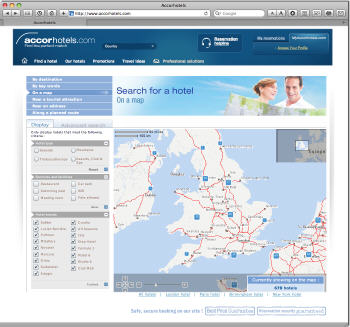Directions Magazine (DM): Can you tell us more about the story of your move from civil aviation to geospatial?
Christian Mandl (CM): I founded and lead SkyEurope Airlines from 2001 to 2007, before exiting my investment to focus on new ventures. That experience in running a listed company showed me that while an organization may have accumulated an impressive amount of data, it's hard to take advantage of all that information without a good visualization tool. In my opinion, visualization is most relevant when it is rooted in a geographic context, because it then provides a link to the real world. I got interested in the geospatial field, and when the Maporama opportunity showed up, I chose to get started immediately, using the valuable assets - an existing know-how and portfolio of customers. The company I founded, Maporama Solutions, is a new legal entity which has taken over the assets of the old structure.
DM: Why the addition of "solutions" in the name?
CM: Providing "solutions" always starts with listening to the customer's needs and translating them into customized applications. It's a different approach from publishing one-size-fits-all products. We believe that with our experience, we can add value and help our customers to handle complex integrations of data and maps. We have an excellent reputation in terms of customer service and responsiveness, and are good at solving problems, so we wanted this to be reflected in our name.
 |
DM: Despite the reputation that it had acquired on the French market, Maporama International seemed to fall rather abruptly. What were the main problems the company had to face, in your opinion?
CM: The main problem came from the perception, induced by the Maporama.com portal, that we were a B2C company, while most of the turnover came from B2B customers. The company used up all of its resources developing new products that didn't always fit into its core area of business, instead of meeting the demand for its expertise in the integration of mapping solutions. Today, the enterprise is redeploying and its international customers already account for 50% of total sales.
DM: How is this offering different from all the other mapping solutions out there?
CM: The map itself is just the background on which to publish data. The added value comes from the layers of "intelligence" that are added on the map and the interactivity in selecting and displaying relevant data. Bing, Google and others are providing maps and contribute to their larger usage, but there is, more than ever, a need for professional integrators.
DM: Can you detail the business model?
CM: The business model is simple: We have standardized applications that can be used and purchased online, and we offer customized solutions where customers pay for a license and the required days of integration.
DM: What are Maporama's key strengths today, and what strategy have you adopted to ensure the revival of the company?
CM: We've applied an old recipe that works: to cut costs and focus on our core business. Our team has eight years of experience in data visualization in a geographic context. In the case of external data, geographic visualization helps match supply with demand to generate higher sales volumes. For data that are used internally, geographic visualization further enriches dashboards and allows getting more out of BI, CRM and ERP tools. As an integrator, we let the client determine what base map to use, whether it's Bing, Google or Maporama.
DM: Are you concerned about the map data wars? What are your plans related to data licensing?
CM: Our view is that the value of map data is going to decrease, that this in turn will generate more demand for mapping solutions and thus more work for professional integrators, so it is rather good news for us. We are able to integrate maps from Bing or Google, or to generate our own maps based on commercial and open source data providers such as NAVTEQ, Tele Atlas and OpenStreetMap.
DM: What are your observations on the state of the French and European geospatial markets?
CM: In Europe and especially in France, the GIS market responds primarily to public sector needs. With the exception of geo-marketing, applications of geographic visualization for businesses are still in their infancy. This may be an image, but many executives still use paper charts and pushpins to see their sales network. In order for them to move toward digital interactive maps, they need simple solutions that will allow them to share information. Traditional desktop applications are still quite exclusive and reserved for an expert audience. The democratization of GIS therefore involves SaaS-type Web applications.
Furthermore, the strength of geographic visualization lies in the possibility of combining enterprise data with contextual socio-economic and demographic data. However, such data are much more accessible in the United States than in Europe, despite the efforts being made for the coordination of statistics. Maporama's experience is precisely about integrating data from multiple sources and displaying them through Web applications. Maporama's solutions primarily meet customer needs which fall short of complex geographic information systems, but are beyond basic mapping.
DM: In the short term, what can we expect from Maporama? Do you have any specific projects you'd like to share?
CM: We have recently developed several Flex applications for our customers, which greatly improve the smoothness of the user experience and enable greater interactivity. We are also able to port our solutions to mobile platforms in order to offer a complete service. In addition, our management tool for displaying data is very much appreciated by our customers. That "toolbox" is extremely convenient and is compatible with all types of maps (Bing, Google, Maporama). We are currently developing online access to these tools so that a wider audience can benefit from them.